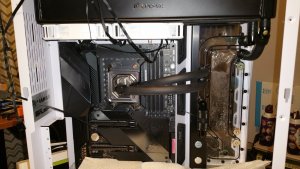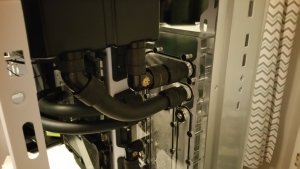kamikazi
[H]ard|Gawd
- Joined
- Jan 19, 2006
- Messages
- 1,601
I have all the parts in hand, EK distro plate for PC-O11 Dynamic, EX Velocity Block, Corsair (HW Labs) radiator, Bitspower fittings, EK ZMT 3/8 ID 5/8 OD tubing, etc. I've been reading up on what needs to be done to prep the radiator and it appears things are all over the place. Some people say hook it up to a hose and flush it with tapwater (which I'm equipped to do), then rinse it out with distilled water. That's actually what I did last time I water cooled about 8 or 9 years ago. Some people talk like touching it with tapwater is the worst thing you could ever do. Some people say use something like Primochill Sys Prep to run in it for a day, then drain it and flush with distilled. Some people say to fill with distilled, shake it up real good and drain it.
I don't have a ton of time to invest (little kids), but I want to do it right (nice oxymoron, I know). What is the most effective way to safely get things ready? I will be running either Koolance Liq 702 clear or EK Cryofuel clear in it. I bought a bottle of each because I was indecisive. I'm heavily leaning towards the Koolance after seeing some horror stories about bad batches of EK Cryofuel and also reading that you can go a long time with Koolance before cleaning. I only have the one 700 ml bottle of Koolance, I'm hoping that's enough for just a CPU loop. I could also be convinced to go with distilled and PT Nuke and maybe some propylene glycol as a DIY. I will most likely leak test in the case for a day or two before running.
Questions:
See above for the question about how to prep the radiator. I'm leaning towards flushing with tap water, then filling with distilled and draining.
Which of my coolant options would you go with? I'm leaning Koolance
I have one of those Bitspower pressure relief plugs that will go in the port that will be the fill port on the distro block. Any issues with that?
I have a Bitspower plug with the temp monitor, ever had issues with one of those leaking?
Do you typically leak test with your preferred coolant and then just leave it be if all is good or do you leak test with distilled, drain, and refill with your coolant of choice?
Anyone build their loop in the case, pull the whole thing out in one piece and leak test outside the case?
I know that a lot of these questions have been asked and answered ad nauseum, but I have some analysis paralysis. The opinions of folks are very strong and often contradict each other. Thanks for your time.
I don't have a ton of time to invest (little kids), but I want to do it right (nice oxymoron, I know). What is the most effective way to safely get things ready? I will be running either Koolance Liq 702 clear or EK Cryofuel clear in it. I bought a bottle of each because I was indecisive. I'm heavily leaning towards the Koolance after seeing some horror stories about bad batches of EK Cryofuel and also reading that you can go a long time with Koolance before cleaning. I only have the one 700 ml bottle of Koolance, I'm hoping that's enough for just a CPU loop. I could also be convinced to go with distilled and PT Nuke and maybe some propylene glycol as a DIY. I will most likely leak test in the case for a day or two before running.
Questions:
See above for the question about how to prep the radiator. I'm leaning towards flushing with tap water, then filling with distilled and draining.
Which of my coolant options would you go with? I'm leaning Koolance
I have one of those Bitspower pressure relief plugs that will go in the port that will be the fill port on the distro block. Any issues with that?
I have a Bitspower plug with the temp monitor, ever had issues with one of those leaking?
Do you typically leak test with your preferred coolant and then just leave it be if all is good or do you leak test with distilled, drain, and refill with your coolant of choice?
Anyone build their loop in the case, pull the whole thing out in one piece and leak test outside the case?
I know that a lot of these questions have been asked and answered ad nauseum, but I have some analysis paralysis. The opinions of folks are very strong and often contradict each other. Thanks for your time.
![[H]ard|Forum](/styles/hardforum/xenforo/logo_dark.png)


